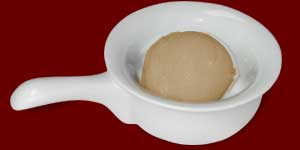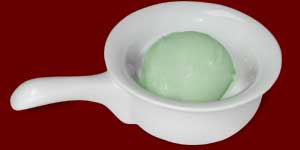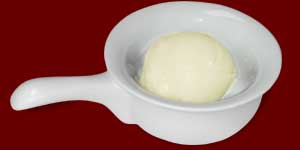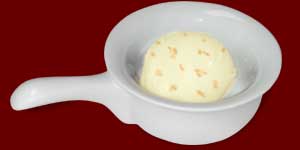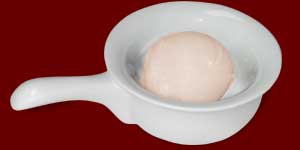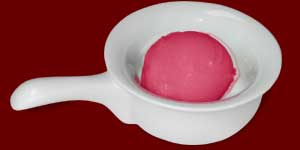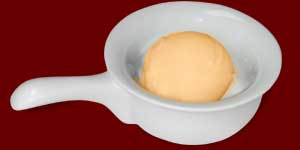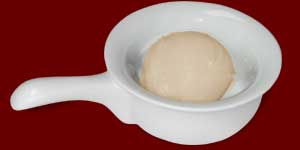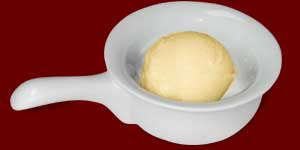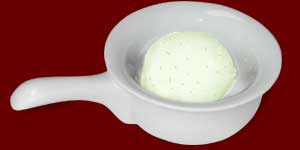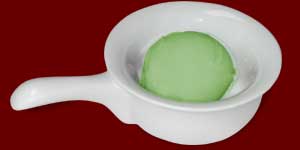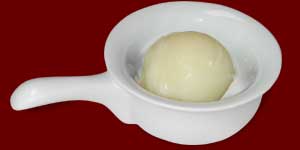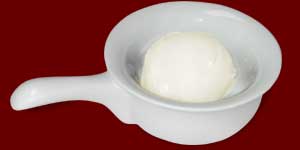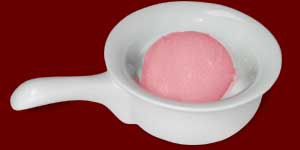




A trip to Paris isn’t really complete without a visit to Berthillon — arguably the best glace (ice cream) and sorbet store in the world. The French have been eating frozen desserts since the eigtheenth century, and they never miss an opportunity to slurp some up. On a warm day, there’s a long line outside the store for both seats and takeout.
Actually, the French word for ice cream is crème glacée, but I’ve only found this term in dictionaries, not cookbooks and magazines. The French term glace is more properly translated as “ice” and many classical recipes are more like modern sorbets than ice cream. Many of the sorbets found on menus in modern France would not actually fit Escoffier’s definition of that frozen dessert. In his time, sorbets were only made of fruit juices or wines. Often these frozen preparations were also mixed with beaten egg whites to make them smoother and lighter. Today’s sorbets made with fruit purées or herbal infusions would be termed glaces by Escoffier.
To better fit modern descriptions and to simplify translation, the recipes in this article are considered glaces (ice creams) if the base includes milk and/or cream, plus eggs. All the remaining preparations are sorbets. Whether a glace or sorbet, all the recipes start with a liquid base. This base is first partially frozen in an ice cream machine and then frozen firm in an ordinary freezer. For all the glaces, a cooked custard is prepared from milk and/or cream, egg yolks, sugar, and flavorings. The custard is chilled before placing it in the ice cream machine.
Depending on the ingredients, some preparations freeze faster or more completely than other preparations. The addition of alcohol to the recipe lowers the freezing point, so this type takes longer to freeze. Sorbet au champagne and sorbet au cidre brut both consist primarily of alcoholic liquids and barely solidify in the freezer. Although there are only a few tablespoons of alcohol in glace malaga, this preparation is soft enough to eat directly from the freezer because of the alcohol it contains.
Using fruit purées is common for modern sorbets. Sorbet aux pêches, sorbet aux framboises, and sorbet aux poires are three examples that can be made from either fresh, frozen, or canned fruit. Glaces — such as glace aux fraises — can also be flavored with fruit purées. Some of the fruit purées used today may be a bit less traditional, such as sorbet aux tomates rouges.
Infusions have also become popular in France as a source of flavor for sorbets. An example is sorbet à la verveine. Infusing the milk or cream used for glaces also produce some interesting flavors. Examples include glace à la menthe, glace à la noix de coco, and glace à la cannelle.
Other glaces included in this article have more conventional flavorings: glace à la caramel, glace au café, and glace à la pistache, although there also are more unusual flavorings, such as glace à l’huile d’olive.
Also included are sorbets which have flavorings that almost move them into the category of glaces. Two examples are sorbet au fromage blanc and sorbet au lait d’amandes.
The recipes included in the article can be modified extensively to fit individual tastes. Glaces can be made more rich by adding additional egg yolks or substituting cream for milk. If the ice crystals form too fast or too large during the freezing process, some powdered invert sugar can be substituted for the ordinary sugar. The amount substituted has to be reduced by half because the invert sugar is sweeter than granulated sugar. If powdered invert sugar is not available, honey can also be used.
Besides the fact that different bases freeze differently, different ice cream machines produce different results. All the recipes in this article have been tested in a one-pint capacity machine with a passive freezing canister chilled to about -22 °C (-8 °F). Generally, the initial freezing is accomplished in about 10 minutes with this machine. Larger machines and quantities will take more time. This is also the temperature required to firmly freeze the partially frozen mixtures tested. If your freezer is not capable of these temperatures, the alcohol based mixtures may not freeze sufficiently for serving.
The recipes in this article can literally be prepared in a few minutes. Glaces and sorbets prepared in the afternoon can easily be ready in time for the evening’s dessert.

©2001, 2014 Peter Hertzmann. All rights reserved.




